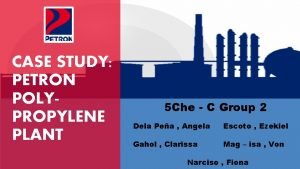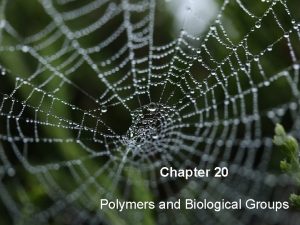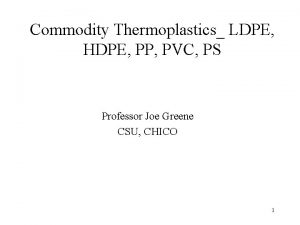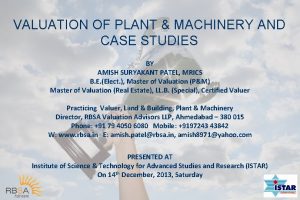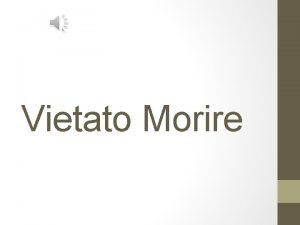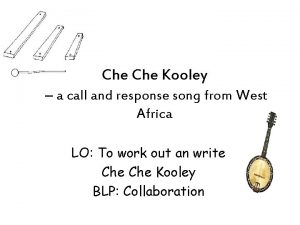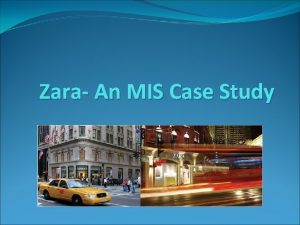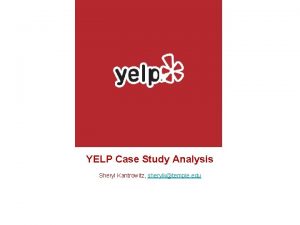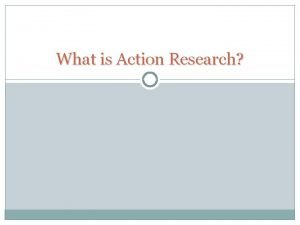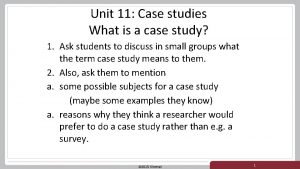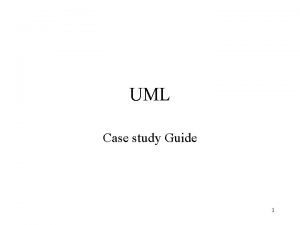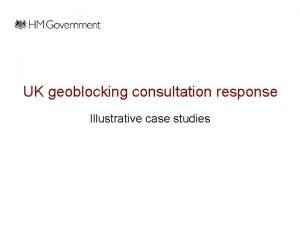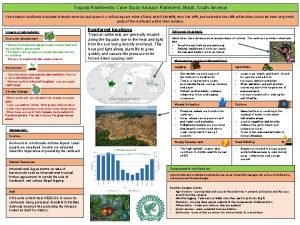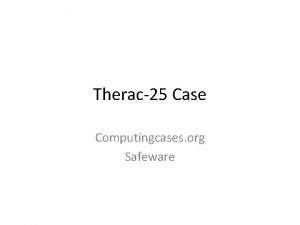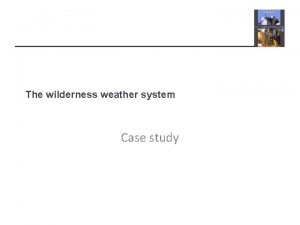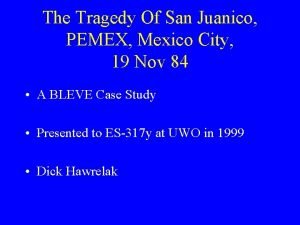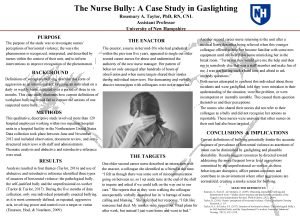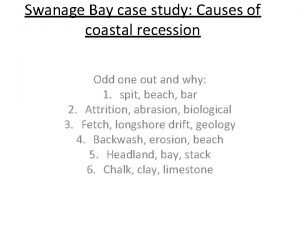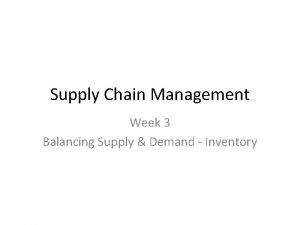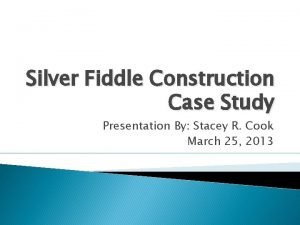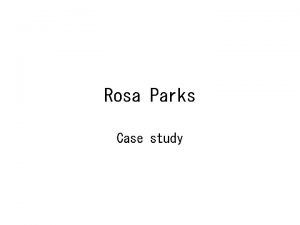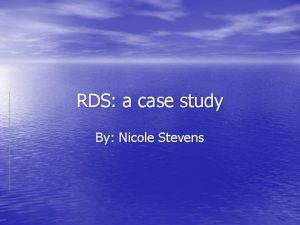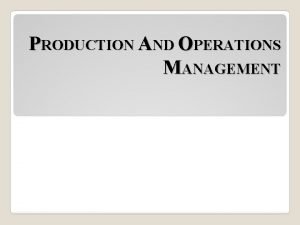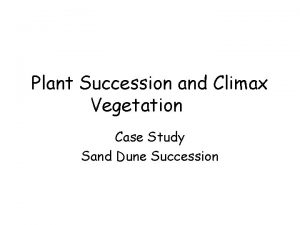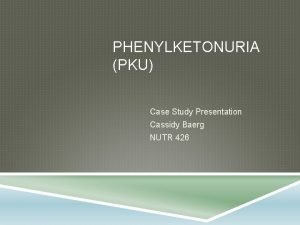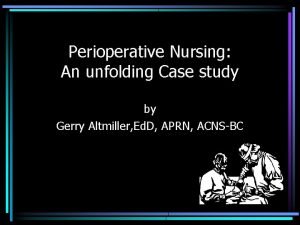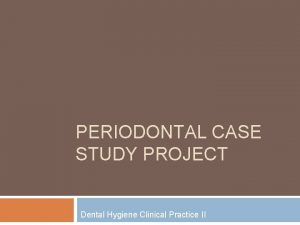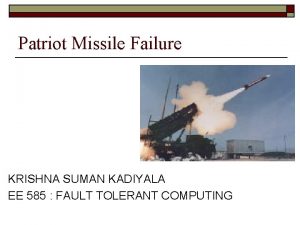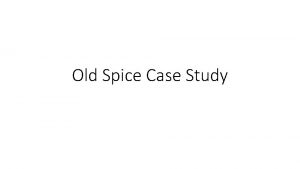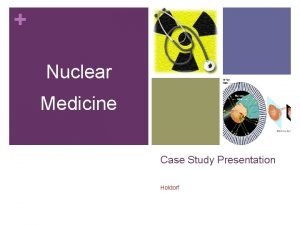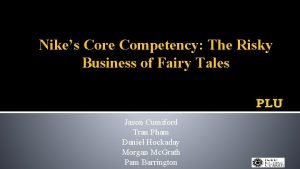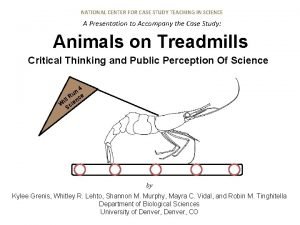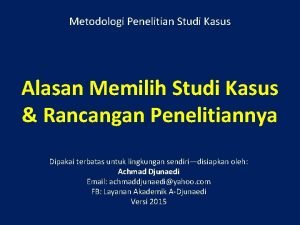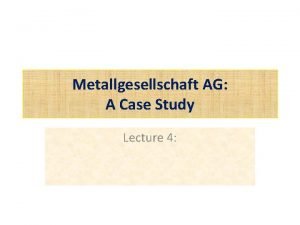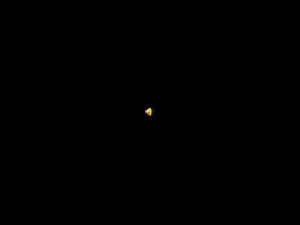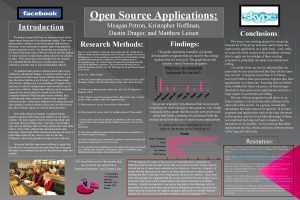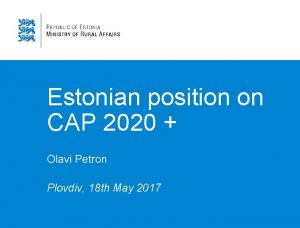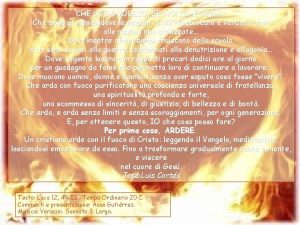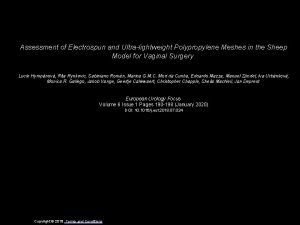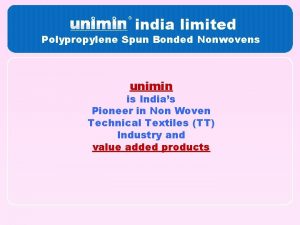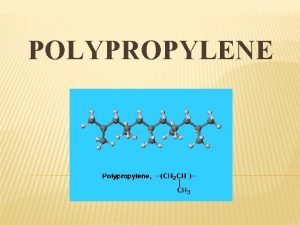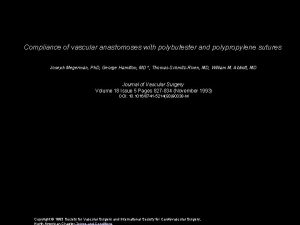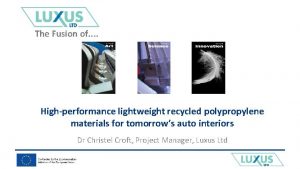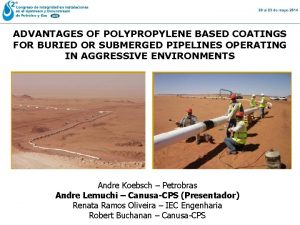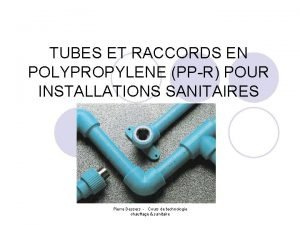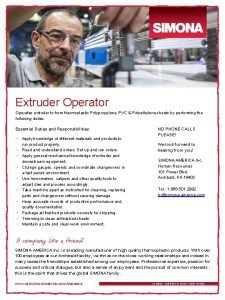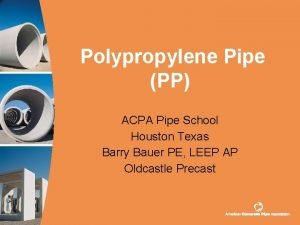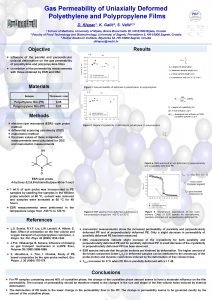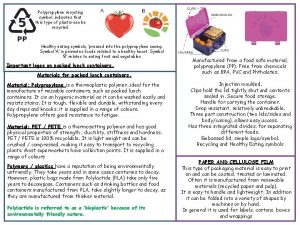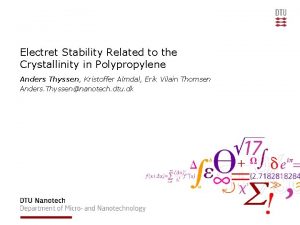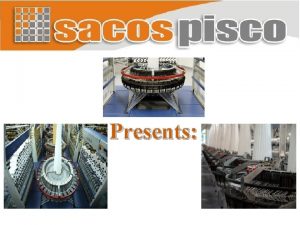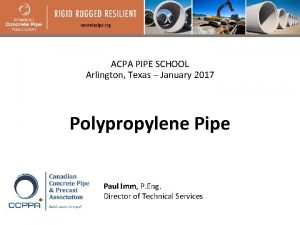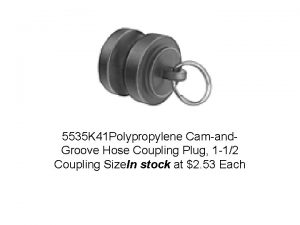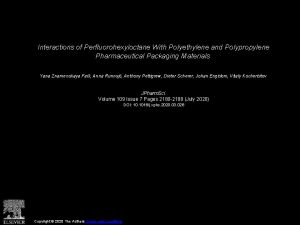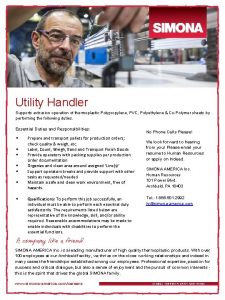CASE STUDY PETRON POLYPROPYLENE PLANT 5 Che C












































































- Slides: 76

CASE STUDY: PETRON POLYPROPYLENE PLANT 5 Che - C Group 2 Dela Peña , Angela Escoto , Ezekiel Gahol , Clarissa Mag – isa , Von Narciso , Fiona

INTRODUCTION up to 51% 40 % of fuel requirement Mariveles, Bataan

COMPANY BACKGROUND polypropylene 160, 000 metric tons

NEED FOR BOILER 3. 5 to 4% of steam requirement

BOILER DESCRIPTION o Low-Pressure Boiler o Type: 3 -pass o Variable flowrate

BOILER SPECIFICATIONS Safety Feature Setting PZAH 11 (safety monostat) causes a malfunction shutdown of LP 1 at 6 barg. Autorestart is not possible SV 960301 6 barg PZAL 33 (monostat) Shut downs burner at fuel oil pressure of 2. 3 barg Shut down pressure of 2. 7 barg

BOILER SPECIFICATIONS Condensate Tank, 960 -03 Capacity 7 m 3 Operating 100 deg Celsius Temperature Maximum Allowable 150 deg Celsius Temperature Operating Pressure 0. 2 -0. 3 bar Maximum Allowable 0. 5 bar Working Pressure Serial number 10844 Year Manufactured 1995

BOILER SPECIFICATIONS Flash Drum, 960 -01 -Z 02 Capacity 0. 024 m 3 Maximum Allowable Temperature 280 deg Celsius Operating Temperature 105 deg Celsius Operating Pressure 0. 3 bar Maximum Allowable Working 0. 5 bar Pressure

BOILER SPECIFICATIONS Condensate Pump, 96 P-03 A 1 B Manufacturer Grunfos Unit Model CR 8 -20 Maximum Allowable 140 deg Celsius Temperature Operating Temperature 105 deg Celsius Capacity 10 tons/hr Discharge Pressure 2. 5 bar (gauge, throttling) Power Consumption 1. 5 k. W Speed 3410 rpm Energy Efficiency 77%

BOILER SPECIFICATIONS Boiler Water Quality p. H at 25 o. C 10. 4 – 11. 4 Conductivity < 500 µS /cm Phosphate (PO 4 -3) 20 – 30 ppm Silica (Si. O 2) < 40 ppm Hydrate Alkalinity 100 - 300 ppm

BOILER SPECIFICATIONS Flue Gas Analysis (once a year) Flue Gas Temperature 67. 41 deg Celsius Ambient Temperature 28 deg Celsius CO 2 %v/v 7. 78% Oxygen 10. 67% Carbon Monoxide 0. 1117% Nitrogen Dioxide 0. 10305% Sulfur Dioxide 0. 09976%

FUEL CHARACTERISTICS Fuel (Diesel) Unit Test Result Lubricity, HFRR; WSD at Micron 198 60 deg Celsius Flame Content Vol% 1. 8 Methyl Laureate (ML) Wt% 0. 96 Sediment by Extraction Wt% 0. 001 Cloud Point Degrees Celsius -1 Pour Point Degrees Celsius -6 Ash Content Wt% 0. 001 Calorific Value, HHV BTU/lb 19630 Calorific Value, LHV BTU/lb 18417 Specification Max 460 1. 7 -2. 2 Min 0. 8 Max 0. 01 Max 10 Max 0. 00100 Min 19600 Min 18400

CALCULATION OF EFFICIENCY USING DIRECT METHOD

CALCULATION OF EFFICIENCY USING DIRECT METHOD Data OPERATING CONDITIONS: Steam generation rate Steam pressure Steam temperature Fuel firing rate GCV of fuel Total surface area Surface temperature Wind velocity Ambient temperature Humidity factor 8000 35 148 450 10912. 854 161 60 2 30 0. 028 Unit kg/hr kg/cm 2 OC kg/hr kcal/kg m 2 OC m/s OC kg/kg of dry air

CALCULATION OF EFFICIENCY USING DIRECT METHOD Boiler efficiency= EFFICIENCY=89. 68%

CALCULATION OF EFFICIENCY USING INDIRECT METHOD

CALCULATION OF EFFICIENCY USING INDIRECT METHOD DATA:

CALCULATION OF EFFICIENCY USING INDIRECT METHOD Theo Air= 0. 141404 kg air/kg coal Mol N 2= 0. 003889 mol Mol C= 0. 000698 mol Theoretical CO 2= 15. 22437 % Excess Air(EA)= 18142. 24 % Actual Air Supplied(AAS)= 25. 79525 kg/kg Actual Mass of Dry Flue Gas(m)= 25. 79 kg DFG/Kg fuel

CALCULATION OF EFFICIENCY USING INDIRECT METHOD HEAT LOSS DUE TO DRY FLUE GAS: L 1 = 2. 343 % HEAT LOSS DUE TO EVAPORATION OF WATER FORMED DUE TO H 2 IN FUEL: L 2= 0. 06045 %

CALCULATION OF EFFICIENCY USING INDIRECT METHOD HEAT LOSS DUE TO MOISTURE IN FUEL: L 3 =0% HEAT LOSS DUE TO MOISTURE IN AIR: L 4= 0. 11142 %

CALCULATION OF EFFICIENCY USING INDIRECT METHOD HEAT LOSS DUE TO INCOMPLETE COMBUSTION: L 5 =0. 0006243% HEAT DUE TO MOISTURE IN AIR: L 6= 0. 13112 %

CALCULATION OF EFFICIENCY USING INDIRECT METHOD HEAT LOSSES: L 1 2. 343 % L 2 0. 06045 % L 3 0% L 4 0. 11142 % L 5 0. 006243 % L 6 0. 131112 % EFFICIENCY=100 -L 1 -L 2 -L 3 -L 4 -L 5 -L 6 EFFICIENCY=97. 3476%

COMPARISON OF EFFICIENCIES DIRECT METHOD: 89. 68 % INDIRECT METHOD: 97. 3476 % RECORDED EFFICIENCY IN THE PLANT: 91 %

CURRENT BAT/BEP PRACTICES

CURRENT BAT/BEP 1 Maintenance for cleaning the boiler § Wet preservation- water filling inside the boiler § HCl and Na. OH are used to demineralize water

CURRENT BAT/BEP 2 Wearing of PPE at all times § § Head Protector Spectacle Long Sleeves Jacket Safety Shoes

CURRENT BAT/BEP Operating the boiler with the following equipment: 3 § § § Economizers Blow down separator (Flash Drum) Condenser Deaerator Water pellet tank

CURRENT BAT/BEP 4 Recording parameters using the following controls: § Pressure control § Temperature control

CURRENT BAT/BEP 5 Conducting a boiler water analysis to check the quality of water by the following properties: § § § p. H Thermal Conductivity Total Dissolved Solids Phosphate, Silica and Iron Content Hydrate Alkalinity

CURRENT BAT/BEP 6 Conducting flue gas analysis once per year Flame detect receptors are installed inside the boiler 7

FIRECAD CALCULATIONS

Put your calculations Here STANDARD OPERATING CONDITIONS

Put your calculations Here USING COAL AS FUEL

Put your calculations Here USING NATURAL GAS AS FUEL

Put your calculations Here INCREASING AMBIENT TEMPERATURE

Put your calculations Here INCREASING NUMBER OF PASSES

Put your calculations Here DECREASING INLET WATER TEMPERATURE

SUGGESTED BAT/BEP

SUGGESTED BAT/BEP 1 Maintain High Ambient Temperature Around Boiler § High ambient temp, high efficiency

SUGGESTED BAT/BEP 2 Waste disposal § Collect solid/liquid waste from combustion process and assess potential for waste reduction and recycling § Minimize environmental release by handling and storing appropriately

SUGGESTED BAT/BEP 3 Automated Combustion Control System § Maintain ideal combustion conditions § Minimization of formation of POPs present in fuel

SUGGESTED BAT/BEP 4 Installation of air pollution control devices § Minimize POPs content of gases

ENVIRONMENTAL ISSUES

ENVIRONMENTAL ISSUES Emissions Based From Flue Gas Analysis of the Boiler:

ENVIRONMENTAL ISSUES Emissions CO 2 emissions • 99% of the fuel oil in the combustion process is converted to CO 2 • It acts as a greenhouse gas which is harmful to our environment • Climate Change, Global Warming

ENVIRONMENTAL ISSUES Emissions Excess O 2 emissions • Parameter for inefficient combustion of boiler fuels • Can cause medical problems by reacting with the lungs and brain

ENVIRONMENTAL ISSUES Emissions CO emissions • Product of incomplete combustion (low temperature) of fossil fuels • Reacts with hemoglobin of the blood to form carboxyhemoglabin. - Hemoglobin is responsible for carrying oxygen to different parts of the body

ENVIRONMENTAL ISSUES Emissions NO 2 emissions • causes the reddish-brown haze in city air, which contributes to heart and lung problems and may be carcinogenic • NOx is an acid precursor • NO 2 + H 2 O -- HNO 3 • Nitrogen dioxides are major contributors to the formation of ground level ‘bad’ ozone.

ENVIRONMENTAL ISSUES Emissions SO 2 emissions • Sulfur dioxide is an acid precursor, which is a source of acid rain produced when SO 2 combines with water droplets to form sulfuric acid, H 2 SO 4 • At relatively high concentrations SO 2 causes severe respiratory problems.

CONCLUSION q. Calculated efficiency using direct method is more accurate than indirect method q. Suggested BAT/BEP shall help in the improvement of the efficiency of the boiler as well as reduce emissions q. Liquid fuel (Diesel) is best suited for Petron’s boiler

CONCLUSION q. Excess oxygen from the Flue gas analysis of the boiler can be harmful to their employees due to it’s dangerous health effects.

THANK YOU FOR YOUR ATTENTION! Inse rt Gr o up p ic here

QUESTIONS?

Let’s Review!

1. What is the type of boiler examined? a. b. c. d. High Pressure Boiler Low Pressure Boiler Medium Pressure Boiler Supercritical Pressure Boiler

2. What would be the effect in efficiency if the fuel fired is coal? a. b. c. d. Significant Increase: Δ >1 Slight Increase: Δ <1 Significant Decrease: Δ >1 Slight Decrease: Δ <1

3. What would be the effect in efficiency if the number of passes increased? a. b. c. d. Significant Increase: Δ >1 Slight Increase: Δ <1 Significant Decrease: Δ >1 Slight Decrease: Δ <1

4. This refers to water filling in the boiler (maintenance) a. b. c. d. Dry Preservation Wet Preservation Full Preservation Half Preservation

5. Where is the boiler located? a. b. c. d. Mariveles, Bataan Pandacan, Manila San Fernando, Pampanga San Rafael, Bulacan

6. Using the 2 methods to obtain efficiency, which result is nearing the recorded efficiency of the plant? a. b. c. d. Direct Method Indirect Method Both Methods Neither

7. How much (in %) does the boiler produces the plant steam requirement? a. b. c. d. 1. 5 -2 % 2 -3. 5 % 3. 5 -4 % 4 -5. 5 %

8. These would minimize POPs a. b. c. d. Water Pellet Tank Process Control Devices Pollution Control Devices Economizer

9. The following are the equipment installed except: a. b. c. d. Flash Drum Water pellet Tank Economizer None of the above

10. a. b. c. d. needs ___ % fuel requirement 40 45 48 51

Let’s Check!

1. What is the type of boiler examined? a. b. c. d. High Pressure Boiler Low Pressure Boiler Medium Pressure Boiler Supercritical Pressure Boiler

2. What would be the effect in efficiency if the fuel fired is coal? a. b. c. d. Significant Increase: Δ >1 Slight Increase: Δ <1 Significant Decrease: Δ >1 Slight Decrease: Δ <1

3. What would be the effect in efficiency if the number of passes increased? a. b. c. d. Significant Increase: Δ >1 Slight Increase: Δ <1 Significant Decrease: Δ >1 Slight Decrease: Δ <1

4. This refers to water filling in the boiler (maintenance) a. b. c. d. Dry Preservation Wet Preservation Full Preservation Half Preservation

5. Where is the boiler located? a. b. c. d. Mariveles, Bataan Pandacan, Manila San Fernando, Pampanga San Rafael, Bulacan

6. Using the 2 methods to obtain efficiency, which result is nearing the recorded efficiency of the plant? a. b. c. d. Direct Method Indirect Method Both Methods Neither

7. How much (in %) does the boiler produces the plant steam requirement? a. b. c. d. 1. 5 -2 % 2 -3. 5 % 3. 5 -4 % 4 -5. 5 %

8. These would minimize POPs a. b. c. d. Water Pellet Tank Process Control Devices Pollution Control Devices Economizer

9. The following are the equipment installed except: a. b. c. d. Flash Drum Water pellet Tank Economizer None of the above

10. a. b. c. d. needs ___ % fuel requirement 40 45 48 51

Good Job!
 Petron polypropylene plant
Petron polypropylene plant Polypropylene functional groups
Polypropylene functional groups Advantages of polypropylene
Advantages of polypropylene Plant and machinery valuation report sample
Plant and machinery valuation report sample Best case worst case average case
Best case worst case average case Fbi virtual case file case study
Fbi virtual case file case study Subordinata oggettiva
Subordinata oggettiva Ricordo quegli occhi pieni di vita
Ricordo quegli occhi pieni di vita Che che kooley
Che che kooley Facesti come quei che va di notte che porta il lume
Facesti come quei che va di notte che porta il lume Di queste case non è rimasto che qualche brandello di muro
Di queste case non è rimasto che qualche brandello di muro Introduction in plant breeding
Introduction in plant breeding Plant breeding for disease resistance
Plant breeding for disease resistance Plant introduction in plant breeding
Plant introduction in plant breeding Tronsmo plant pathology and plant diseases download
Tronsmo plant pathology and plant diseases download Tronsmo plant pathology and plant diseases download
Tronsmo plant pathology and plant diseases download Tronsmo plant pathology and plant diseases download
Tronsmo plant pathology and plant diseases download Difference between short case and long case
Difference between short case and long case Binary search time complexity worst case
Binary search time complexity worst case Glennan building cwru
Glennan building cwru Bubble sort best case and worst case
Bubble sort best case and worst case Bubble sort best case and worst case
Bubble sort best case and worst case Bubble sort best case and worst case
Bubble sort best case and worst case What is a unique triangle
What is a unique triangle Zara information system
Zara information system Sheryl kantrowitz
Sheryl kantrowitz Patient kf case study
Patient kf case study Swot analysis of whole foods
Swot analysis of whole foods Action research vs case study
Action research vs case study Volkswagen of america managing it priorities
Volkswagen of america managing it priorities Mini case study example
Mini case study example Starbucks foreign direct investment case study
Starbucks foreign direct investment case study Case study 11
Case study 11 Uml case study
Uml case study Illustrative case study example
Illustrative case study example Tuna for lunch case study answer key
Tuna for lunch case study answer key Tuna for lunch case study answer key
Tuna for lunch case study answer key The amazon rainforest case study
The amazon rainforest case study Supermarket seo case study
Supermarket seo case study Threats to biodiversity a case study of hawaiian birds
Threats to biodiversity a case study of hawaiian birds Mount st helens plates involved
Mount st helens plates involved Therac-25 case study
Therac-25 case study Wilderness weather station
Wilderness weather station Bleve san juanico
Bleve san juanico Gaslighting case study
Gaslighting case study Coyote removal case study answers
Coyote removal case study answers Semi structured questionaire
Semi structured questionaire Spend analysis case study
Spend analysis case study Telegram roadmap
Telegram roadmap Swanage bay case study
Swanage bay case study Maq corporation case study
Maq corporation case study Case 7.2 silver fiddle construction
Case 7.2 silver fiddle construction Linear programming case study examples
Linear programming case study examples Rosa parks case study
Rosa parks case study Advantages and disadvantages of volunteer sampling
Advantages and disadvantages of volunteer sampling Rds case study
Rds case study Ethnography and case study compare
Ethnography and case study compare Phenomenology vs case study
Phenomenology vs case study Location strategy in operations management
Location strategy in operations management Climax stage
Climax stage Pku case study answers
Pku case study answers Perioperative case study nursing
Perioperative case study nursing Gingival description
Gingival description Cargill everyday performance management
Cargill everyday performance management Patriot missile
Patriot missile Your garden gloves case study answers
Your garden gloves case study answers Old spice case study
Old spice case study Medical case study presentation
Medical case study presentation Core competency of nike
Core competency of nike National centre for case study teaching in science
National centre for case study teaching in science National center for case study teaching in science
National center for case study teaching in science National center for case study teaching in science
National center for case study teaching in science National center for case study teaching in science
National center for case study teaching in science Case study on microsoft azure in cloud computing
Case study on microsoft azure in cloud computing Mengapa memilih studi kasus
Mengapa memilih studi kasus Kelebihan studi kasus
Kelebihan studi kasus Mgrm case study
Mgrm case study
